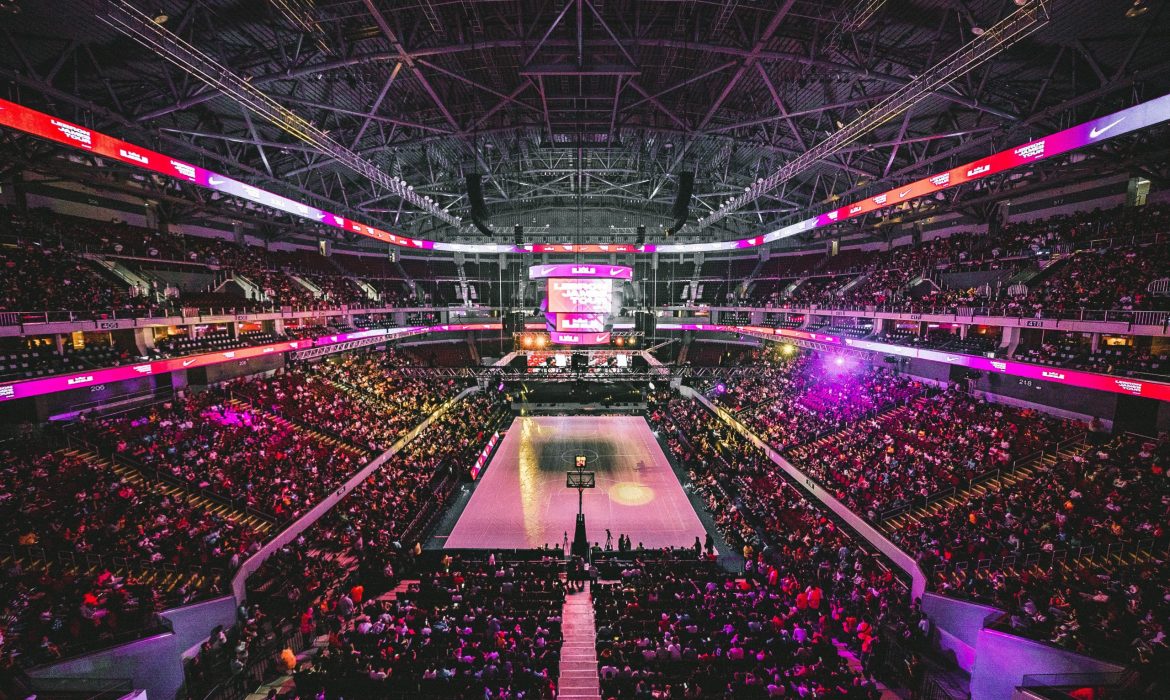A quick guide to understanding esports and gaming fans
Some weeks ago, I presented hard evidence to prove that esports are very promising for broadcasters, especially due to audience growth and the monetisation opportunities available.
Now, it’s time to check who watches digital esports and how they do so to better understand the habits of this group.
A stereotype-busting range of ages
While gaming may sometimes be viewed as a novelty, it has been present in popular culture since way back in the early 70s – back when Pong was released by Atari. Since then, thanks to the rapid development of technology, games are a popular pastime for many people across the globe. And not necessarily just young people.
This is how it looks in the US, regardless of gender:
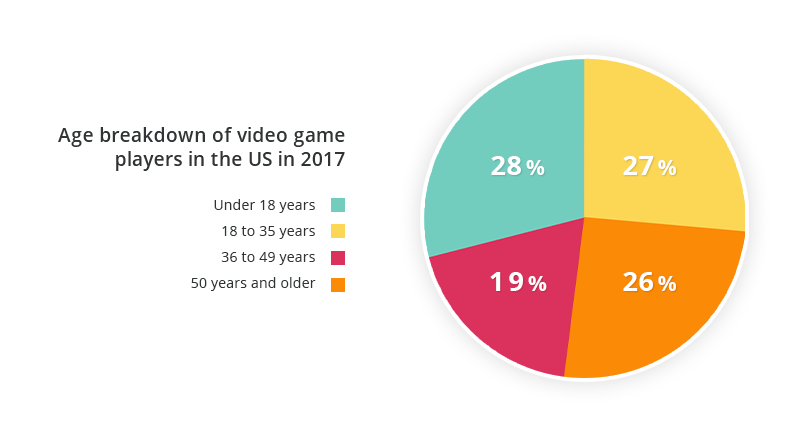
In the above, the 26% of 50+ gamers may remember playing the original Pong, released in pre-internet times and when Richard Nixon was in the Oval office! With almost one-third of players under 18, it looks as though games continue to have a presence throughout someone’s whole life. Most likely, today’s under-18 gamers played their first games on a smartphone or other mobile device however!
Elsewhere, other research has shown that the average gamer is 35 years old – with female players at 37 years old and male ones at 33[2]. These stats alone are enough to make you rethink this audience.
Females play too!
While the common stereotype of a gamer often refers to them as male teenagers or young men, the reality is a bit more complex. Women have a strong presence in gaming communities – 41% of US video game fans are women. This is compared to 59% men across all ages:
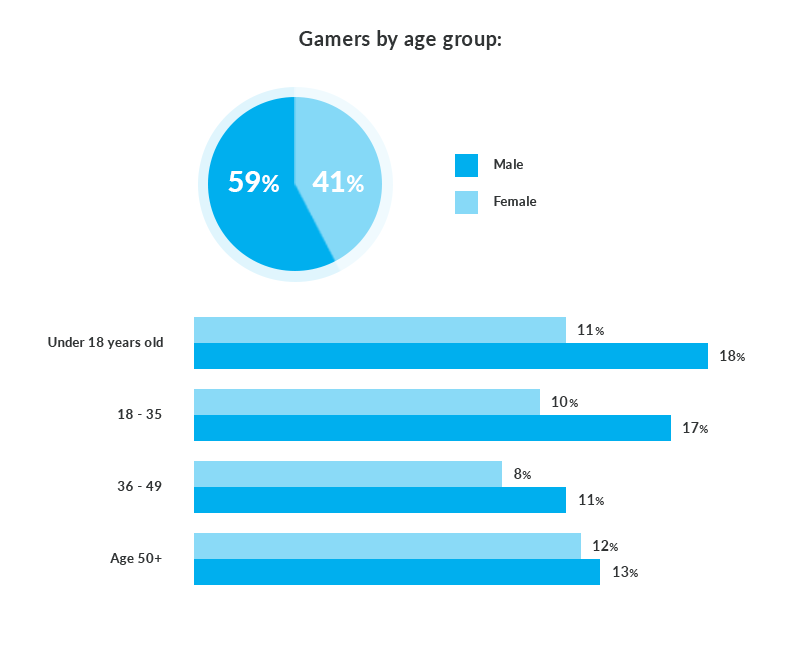
Gaming devices are widespread
In the US, 67% of households own a device that is used to play video games – either a PC, smartphone, wireless device, game console, handheld system or virtual reality device. In 65% of these US households there’s at least one person who plays three or more hours of video games a week. [4]
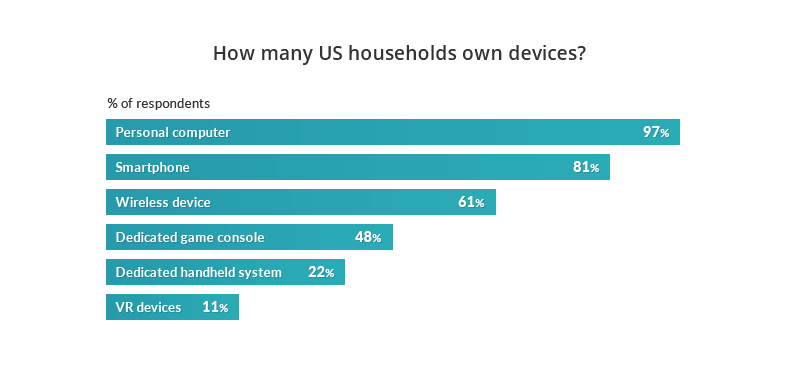
What’s worth a mention here is that gaming devices are very often ‘watching’ devices at the same time. PCs, laptops, smartphones and tablets are multipurpose and very often used as second screens.
To game, or just watch?
There are a lot of similarities between fans of traditional sports and esports. Like this one – that they will often prefer to watch events than actually play the sport (or esport) themselves. According to research by Newzoo, which focused on three of the most popular esports franchises – League of Legends (LoL), Counter-Strike: Global Offensive (CS:GO) and Dota 2 – [bctt tweet=”42% of esports viewers do not play the games they watch.” username=”TellyoTV”]
There are further similarities, with 70% of esports fans surveyed by Newzoo watching only content dedicated to one of the three games mentioned above.
So, how many sports are you following or how many teams do you actively support?
Esports fans aren’t very lavish… yet
The average spend by esports fans on their hobby is $3.64. Another $0.33 should be added as revenue from merchandise, event tickets and subscriptions. All in all, that’s not a great deal of spend, especially bearing in mind the huge prizes available at esports tournaments.
But this rapidly growing market isn’t saturated like traditional sports. For comparison – the average global revenue for a basketball fan is $15 per year, while $54 for all sports.
So, what’s behind such a big difference between esports and traditional sports?
- Esports are popular, but we’re unable to compare their popularity to traditional sports just yet.
- Traditional basketball, football or hockey leagues, for example, are often very well organised. They will have lots of sports events throughout the year and most countries will have their own leagues and cups etc.
- Merchandising in traditional sports is huge, bringing enormous profits to teams, sponsors and partners.
- Youth training systems are often in place for well-established sports – for example, football academies offer more structure for young players.
- Traditional sports get more publicity – their most popular players are pop-culture stars and recognisable around the world.
- Years of tradition – something esports naturally lack for now.
Revenues look to be rising
Average esports revenue per fan is growing and is optimistically forecasted to hit 3 billion dollars globally in 2020. This would count for $11 revenue per fan – which is quite an amount![5]
What’s fuelling such optimistic forecasts regarding future revenues from esports? Let the numbers speak:
- 43% of esports fans in US are earning $75 000 or more annually.
- 31% of esports fans in US have an annual income reaching $90, 000 or more.
According to the same survey, 57% of esports enthusiasts are over 25 years old and live with their children. Can we assume that someday they will pass their passion to younger generations? Well, we can’t foresee this for sure, but it seems pretty plausible[6].
A growing audience
Esports are gaining in popularity very quickly. Some predictions suggest that in 2020 there will be 286 million hard-core, esports enthusiasts and more than 300 million occasional viewers globally. Combining these two figures gives you some idea just how big esports might be in the coming years.
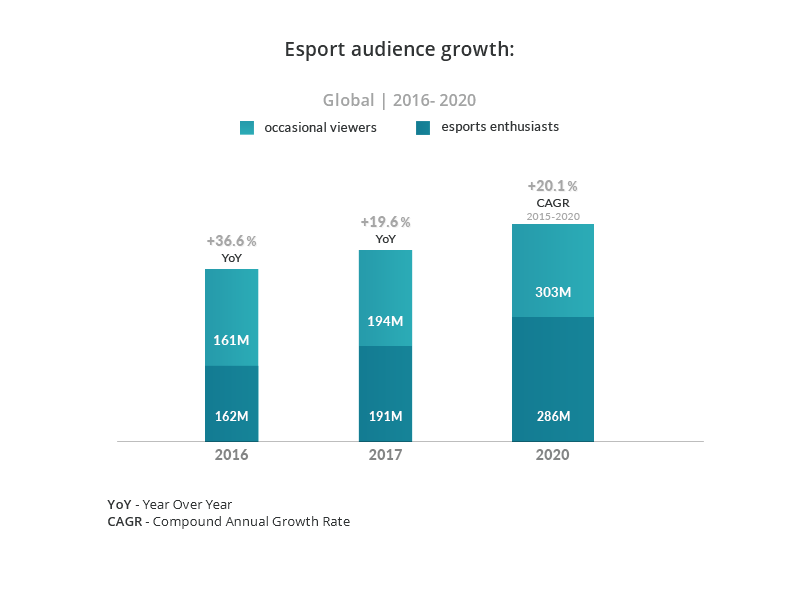
Interesting prospects
Beyond any doubt, esports fans and gamers are interesting prospects now and into the future. They represent a massive audience that brands, broadcasters and rights holders can tap into.
As an audience, esports fans and gamers are:
- Demographically diverse, with some surprising audience segments.
- Like traditional sports fans in the way they are often loyal to only a few favourite titles.
- Rising in numbers, with audience growth continually expanding.
- Limited in ways they can show their support and love for esports with their wallets, besides watching streams and buying and playing games.
As a new type of entertainment, esports are still in a nascent stage – and the world of traditional sports can look saturated in comparison. Esports’ popularity is rapidly growing and there’s still time to jump on the bandwagon before it moves too fast like the flick of a gamer’s thumb.
[1], [2], [3], [4] Source 1,2,3,4
[5] 2017 Global esports market report, Newzoo
A recipe for video content success: Lonzo Ball and the Summer League buzz
While it’s not everyone’s favourite, partly due to being played in the silly season, this year’s NBA Summer League was truly special. Lonzo Ball was the star earning MVP status on the court, while his father courted controversy off it. The surrounding buzz led to record viewing figures – with six of ESPN’s seven most-viewed games featuring the LA Lakers draft star.
ESPN proved willing to run with the Lonzo hype and the buzz his father, LaVar, was able to build around him. The channel struck gold with the duo, and their presence helped to build a buzz around the Summer League.
Some of the factors that helped build a buzz:
- A superstar in the making
There’s no doubt, Lonzo is a superstar on the rise. He has outstanding skill and is an unusual size for his position, which makes him an interesting proposition. It didn’t hurt that he brought passion and emotion to the court in front of big crowds in the stands and on TV, making him the Summer League’s Most Valuable Player.
- Lonzo, the lead story
Matching his performances, Lonzo maintained a position as the most written-about player throughout the Summer League. Media Cloud stats tell the story – he outpaced other players with 702 mainstream news stories, more than the 2nd and 3rd players combined.
- LaVar, a slice of controversy
There’s no doubt that “a ton of the attention Lonzo receives stems from his brash, outspoken father, LaVar,” according to a fantastic article on the FiveThirtyEight website. As he tried to bolster his family’s brand value any way he could, one of LaVar’s standout comments was to claim he was a better basketball player than Michael Jordan. Tweeters used #lavarballsays to mock him (ironically adding more fuel to the selfless promotion of the Ball name).
- The media were kept guessing
With Lonzo yet to sign a shoe deal with one of the major brands, masses of media attention surrounded what sneakers he would wear. This speculation was only encouraged by the Ball family releasing their Big Baller Brand shoes. So every time Lonzo put on a different pair of sneakers, people would be asking is it another marketing ploy?
What was the recipe for ESPN’s success?
ESPN fully capitalised on the buzz surrounding the Summer League. By combining TV broadcasts with video content and social media activity, the channel was able to engage its audience and even make some good gains. For example, 2017 Google Trends data shows huge increases in searches related to ‘NBA Summer League’.
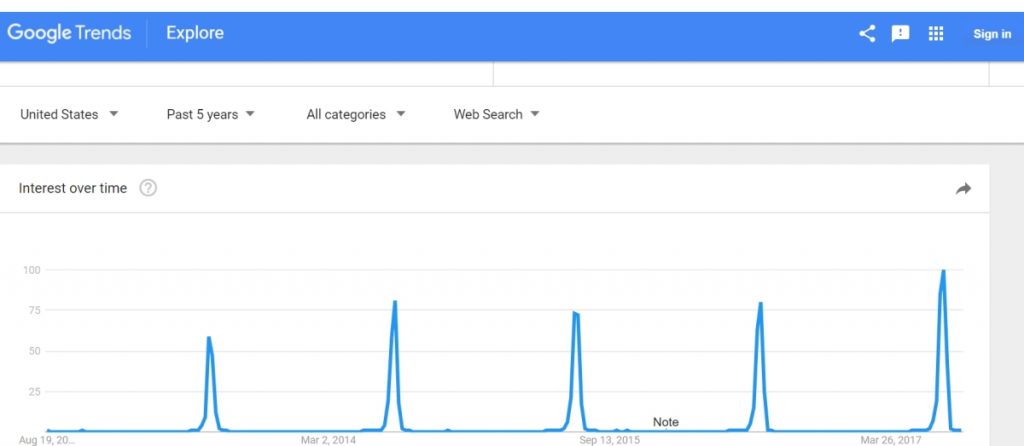
Google Trends for “NBA Summer League” term popularity
ESPN seemed to get its mix of ingredients just right.
- Great timing
The silly season is usually a bad time to break records. But the game between two great teams (Boston Celtics vs LA Lakers) and the duel between draft picks 2 and 3 (Lonzo Ball of the Lakers vs Jason Tatum of Celtics) presented opportunities for ESPN.
To hype the game, ESPN broadcasted a three-part documentary – Best of Enemies – exploring the Celtics/Lakers rivalry as part of its 30 for 30 series. The game itself was the most-watched Summer League game ever, with over 1.1million views on ESPN.
- Tons of shareable content dedicated to Lonzo Ball
Through content, ESPN were able to build a narrative thread that resonated with fans. It managed to maintain the hype surrounding the lead star, presenting Lonzo Ball as the future superstar and maybe as good as his father claims he is!
More than 1,000 articles and videos dedicated completely or partially to Lonzo or other Ball family members have also been created by ESPN.
- Big characters can add to the story
Lonzo Balls’ father, LaVar, was definitely one of the stars of the Summer League. You can dislike him, but the hype around his son is definitely his success. His opinions also get him airtime. On ESPN’s First Take Show, LaVar gets into a heated debate regarding his views on beating Michael Jordan in a game of one-on-one!
You may not have a Lonzo in your locker, or even want a LaVar on your team! But I hope you can take away some of the ingredients that created such a buzz around the Summer League and made it such a success.
How to incorporate sponsorship into your real-time social videos
To benefit both you and your sponsors we’ve developed our Tellyo platform in three ways:
to bump sponsor branding to the fore, power visual presentation and improve collaboration.
We’ve done so because real-time social videos provide a golden opportunity for sponsors. They’re an ideal way to get a sponsor’s name in front of audiences online and for sponsors to tap into the incredible emotional value of memorable moments.
[bctt tweet=”Real-time social videos provide a golden opportunity for sponsors. ” username=”TellyoTV”]
The stats will satisfy sponsors looking to enhance reach, gain impressions and engage audiences. Video represents 74% of all internet traffic, while internet searches with the suffix ‘video’ are rapidly on the rise. Cisco predicts this will top 80% for consumer traffic by 2019. Engagement is highest on social media posts that contain video.
Three ways to incorporate sponsorship using Tellyo
1. By adding branded bumpers
Branded bumpers, such as an animated sponsor’s logo at the start of a video, can balance your sponsors’ needs while not turning off audiences with commercial messages. These audiences will want immediacy and to get to video content quickly.
Because they’re less intrusive, lightweight in size and fast when loading, short bumpers will appeal to impatient mobile users in particular. A trend led by You Tube with its six-second bumper ads.
In Tellyo you can automatically add pre-prepared bumpers to every video. This will not only speed up your team’s ability to create and share videos in real time. But also means no one will forget to include your sponsor’s logo in the rush to create and share content in the now.
2. Giving more visual power to brands
With four-times as many consumers preferring to watch a video than to read text, the power of visual presentation comes into play for brands.
This need to ‘get visual’ is something that Chief Marketing Officers understand according to a CMO Council study. Visual assets – such as video, photos, illustrations and infographics – are core to how a brand story is communicated.
Using Tellyo, you can create visually captivating videos that bring sponsors into your brand’s story. These videos can include visual effects such as overlays for captions and sponsor logos. Bespoke overlays can be easily created to fit your sponsors’ needs.
3. Through greater collaboration
Our platform has been built to enable greater collaboration between you and your sponsors. You can give them access to content, meaning they can distribute your videos direct from the platform on your behalf.
In Tellyo, access can be easily managed by adding rules, so it’s always you who is in control of how your video content is shared. What’s more, Tellyo provides concrete data that is available for all teams to access in real time. This means you can track and analyse performance, such as shares, reach and impressions, with greater accountability and a tangible return on investment in mind.
How to incorporate sponsorship into your real-time social videos
To benefit both you and your sponsors we’ve developed our Tellyo platform in three ways:
to bump sponsor branding to the fore, power visual presentation and improve collaboration.
We’ve done so because real-time social videos provide a golden opportunity for sponsors. They’re an ideal way to get a sponsor’s name in front of audiences online and for sponsors to tap into the incredible emotional value of memorable moments.
The stats will satisfy sponsors looking to enhance reach, gain impressions and engage audiences. Video represents 74% of all internet traffic, while internet searches with the suffix ‘video’ are rapidly on the rise. Cisco predicts this will top 80% for consumer traffic by 2019. Engagement is highest on social media posts that contain video.
Three ways to incorporate sponsorship using Tellyo
1. By adding branded bumpers
Branded bumpers, such as an animated sponsor’s logo at the start of a video, can balance your sponsors’ needs while not turning off audiences with commercial messages. These audiences will want immediacy and to get to video content quickly.
Because they’re less intrusive, lightweight in size and fast when loading, short bumpers will appeal to impatient mobile users in particular. A trend led by You Tube with its six-second bumper ads.
In Tellyo you can automatically add pre-prepared bumpers to every video. This will not only speed up your team’s ability to create and share videos in real time. But also means no one will forget to include your sponsor’s logo in the rush to create and share content in the now.
2. Giving more visual power to brands
With four-times as many consumers preferring to watch a video than to read text, the power of visual presentation comes into play for brands.
This need to ‘get visual’ is something that Chief Marketing Officers understand according to a CMO Council study. Visual assets – such as video, photos, illustrations and infographics – are core to how a brand story is communicated.
Using Tellyo, you can create visually captivating videos that bring sponsors into your brand’s story. These videos can include visual effects such as overlays for captions and sponsor logos. Bespoke overlays can be easily created to fit your sponsors’ needs.
3. Through greater collaboration
Our platform has been built to enable greater collaboration between you and your sponsors. You can give them access to content, meaning they can distribute your videos direct from the platform on your behalf.
In Tellyo, access can be easily managed by adding rules, so it’s always you who is in control of how your video content is shared. What’s more, Tellyo provides concrete data that is available for all teams to access in real time. This means you can track and analyse performance, such as shares, reach and impressions, with greater accountability and a tangible return on investment in mind.



